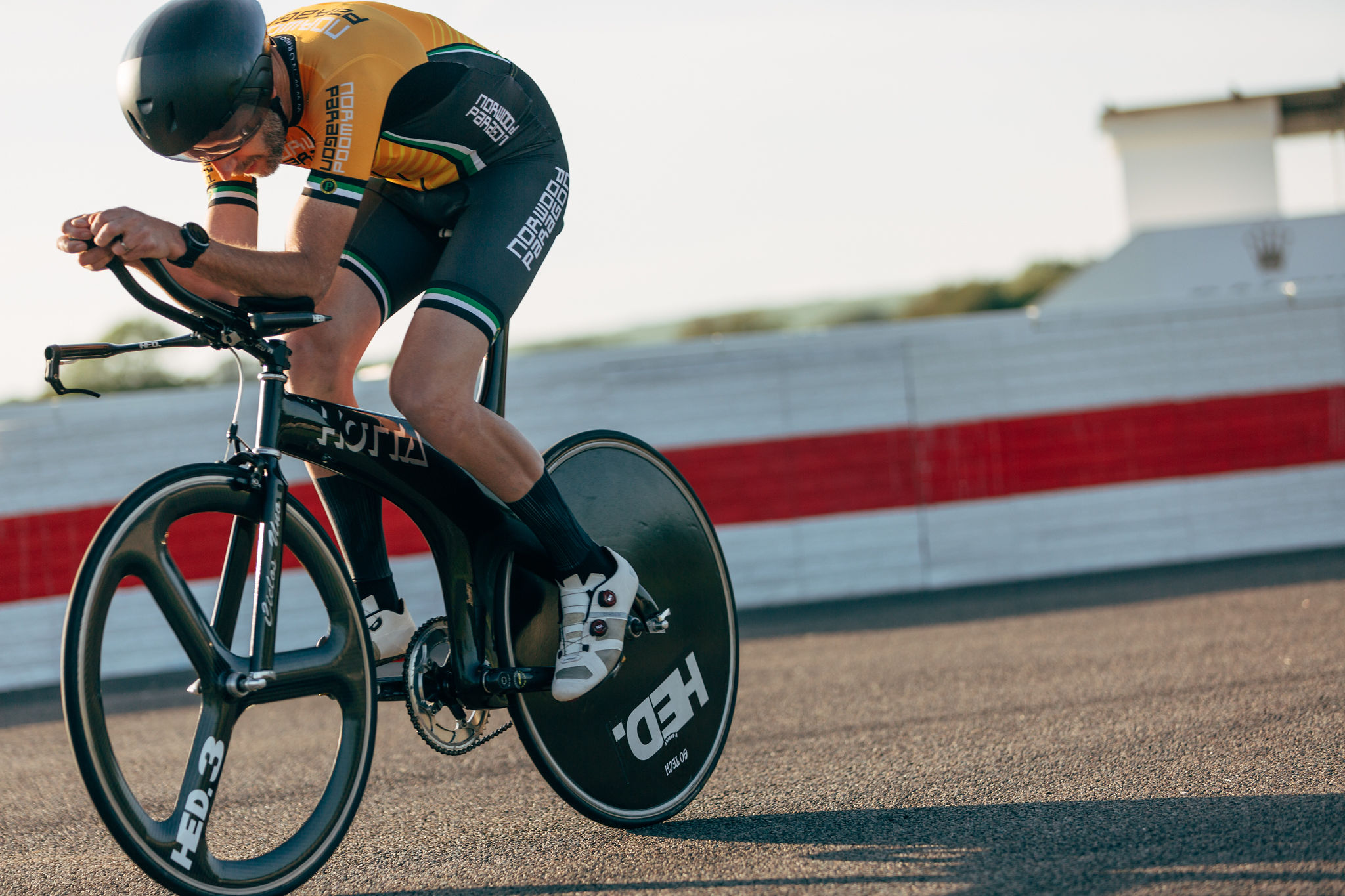What is Zwift? Everything you need to know about the online training and racing platform
Find out how to get started in the virtual cycling world of Zwift with our complete guide
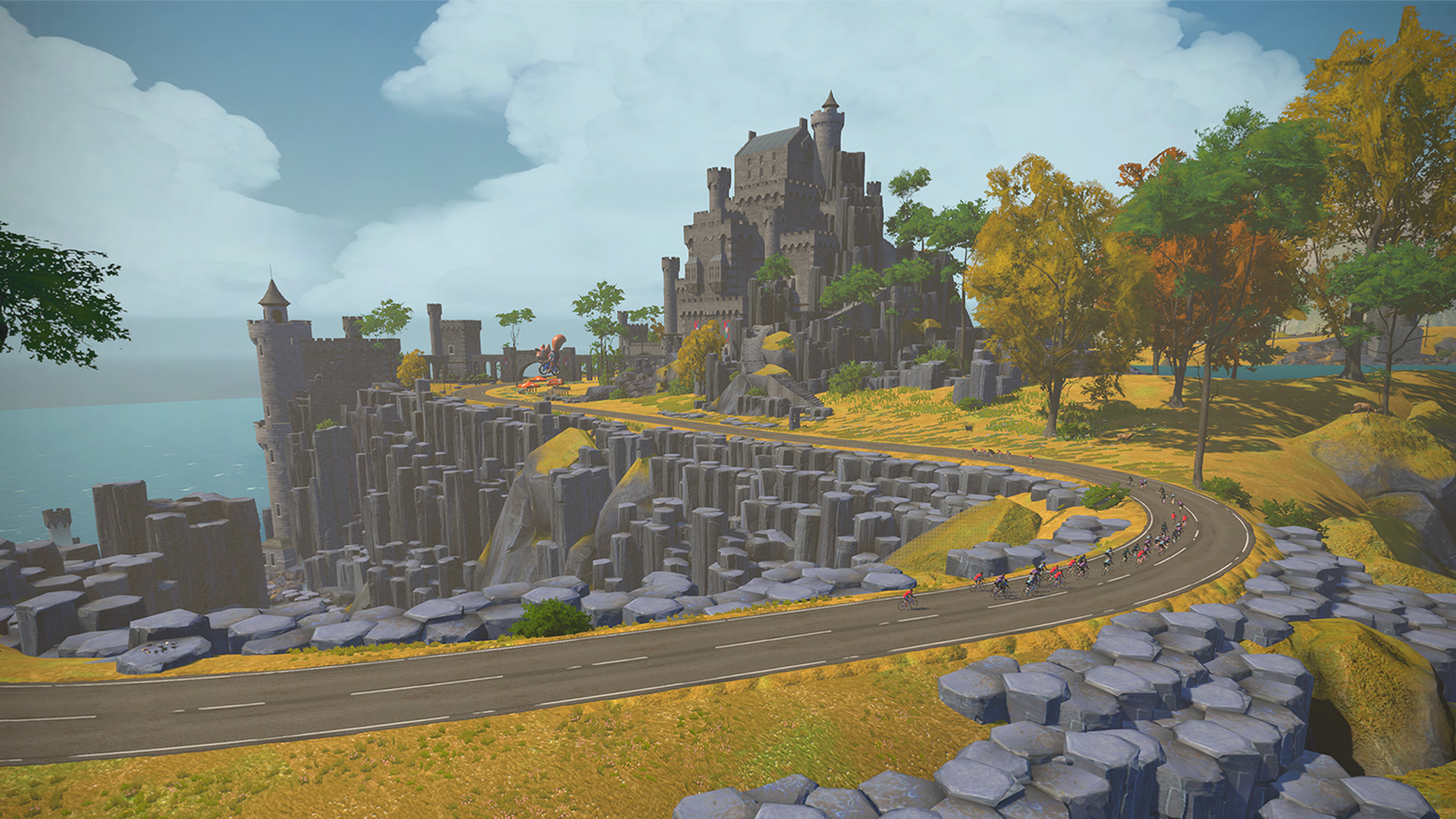

One of the best ways of keeping fit and motivated throughout the year, rain or shine, is to use an indoor training and racing platform. There are plenty of options out there, but Zwift dominates the category over the years has become synonymous with indoor cycling. Just as 'Garmin' is often used to mean a generic cycle computer, although the likes of Wahoo and Hammerhead are catching up, you'll frequently hear indoor riding referred to as 'Zwifting'.
Zwift has expanded since it launched in 2014 to offer 12 virtual worlds, more than 150 routes, and a vast number of workouts and structured training plans – which is great news for Zwift's thousands of subscribers, but on the flip side it can make it potentially difficult to know where to start if you're not yet Zwifting.
So, if you're thinking of giving it a go, below is everything you need to know to get started on Zwift.
And if you're curious to know what else is on offer, our best indoor training apps page can help you find the perfect indoor cycling motivation.
What is Zwift?
Zwift is an online indoor training application that enables you to link your turbo trainer or smart bike to your computer, tablet, smart phone, or Apple TV, letting you ride or race with other cyclists in a virtual environment. Once upon a time there was just a garage wall to look at – with Zwift's vibrant technicolour worlds those days are long gone.
Zwift takes power data from your turbo trainer or smart bike and converts it into speed on the virtual road your avatar is riding on, using your weight to calculate watts per kilo, height for your coefficient of drag, and taking into account the virtual gradient or road surface that you're tackling.
As well as competing against others riders in Zwift races and time trials, such as the iconic Cycling Weekly Club 10, if you're looking for specific training sessions there are workouts designed by professional coaches, as well as group rides that you can participate in with other riders. If you're not able to join a specific workout at an allotted time, there are Robo Pacer groups that are active 24/7 that you dip in and out of as you please.
The latest race content, interviews, features, reviews and expert buying guides, direct to your inbox!
These Robo Pacer rides award you with added 'Drops' the virtual currency within Zwift to purchase virtual bikes, wheels, or upgrade these components. You can also accumulate Drops by levelling up, all the way to Level 100, or by riding up gradients and at higher intensities. XP is awarded on a 20/km or 30/mile basis, while completing new Routes gives you an added boost based on the distance of the route.
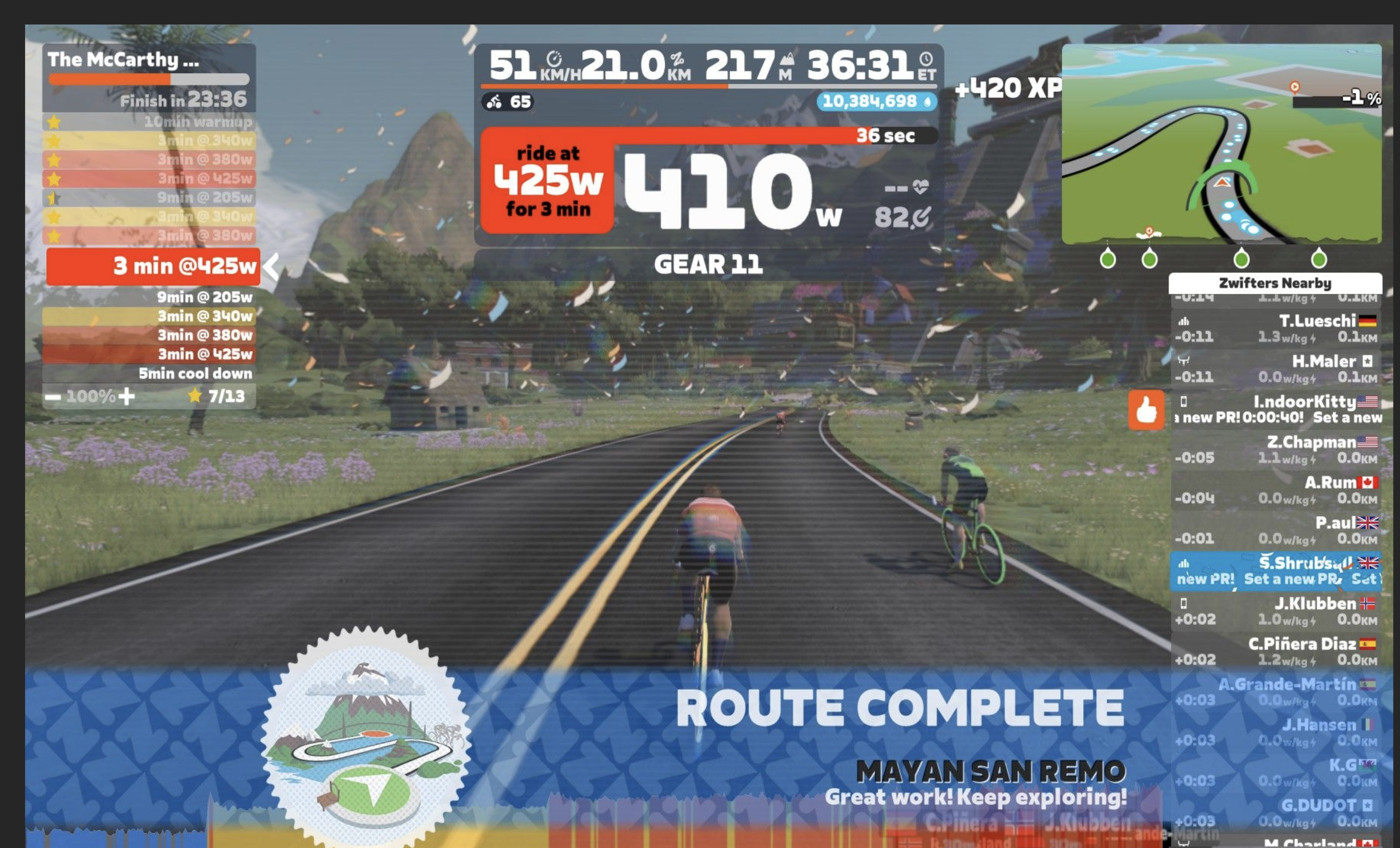
Zwift takes the boredom out of turbo training
There's a total of 12 virtual worlds to choose from – including Watopia, New York, Paris, London, Scotland and Makuri Islands – and hundreds of kilometres on virtual routes to ride. The latest update was for the New York world that came this October, and is their biggest map extension for five years
Is Zwift free?
In a word, no. Zwift costs £17.99 or $19.99 a month but you cancel at any time. You can also save some money by going for an annual subscription for £179.99/$199.99.
You don’t need to commit immediately, either, as there is a seven day free trial available to all new members.
What equipment do I need to ride on Zwift?
The main thing you need to use Zwift is a turbo trainer. If you want immersive gameplay, are going to be using Zwift regularly, and can afford it, the Wahoo Kickr or Tacx Neo 2T are good options. But this is a growing market and the technology is updating all the time. Our guide to the best smart turbo trainers is a good place to start.
One of the best options for those on a budget comes from Zwift themsleves who teamed up with Wahoo to offer the Wahoo KICKR Core 2 with Zwift Cog for a very competitive £499.99. Meanwhile more budget options are available with the Van Rysel D100 with Zwift Cog for just £279.99. You can even double up on the Wahoo KICKR Core 2 by getting it with the Zwift Ride smartbike for £1099.99 or £749.99 for the bike on its own which we are a massive fan of.
In addition to this, our page on how to get a cheap Zwift setup: what you need is worth a look if you have a set budget in mind. And if you want to understand what features you should expect to get at various price points, check out our explainer on the differences between cheap versus expensive turbo trainers.
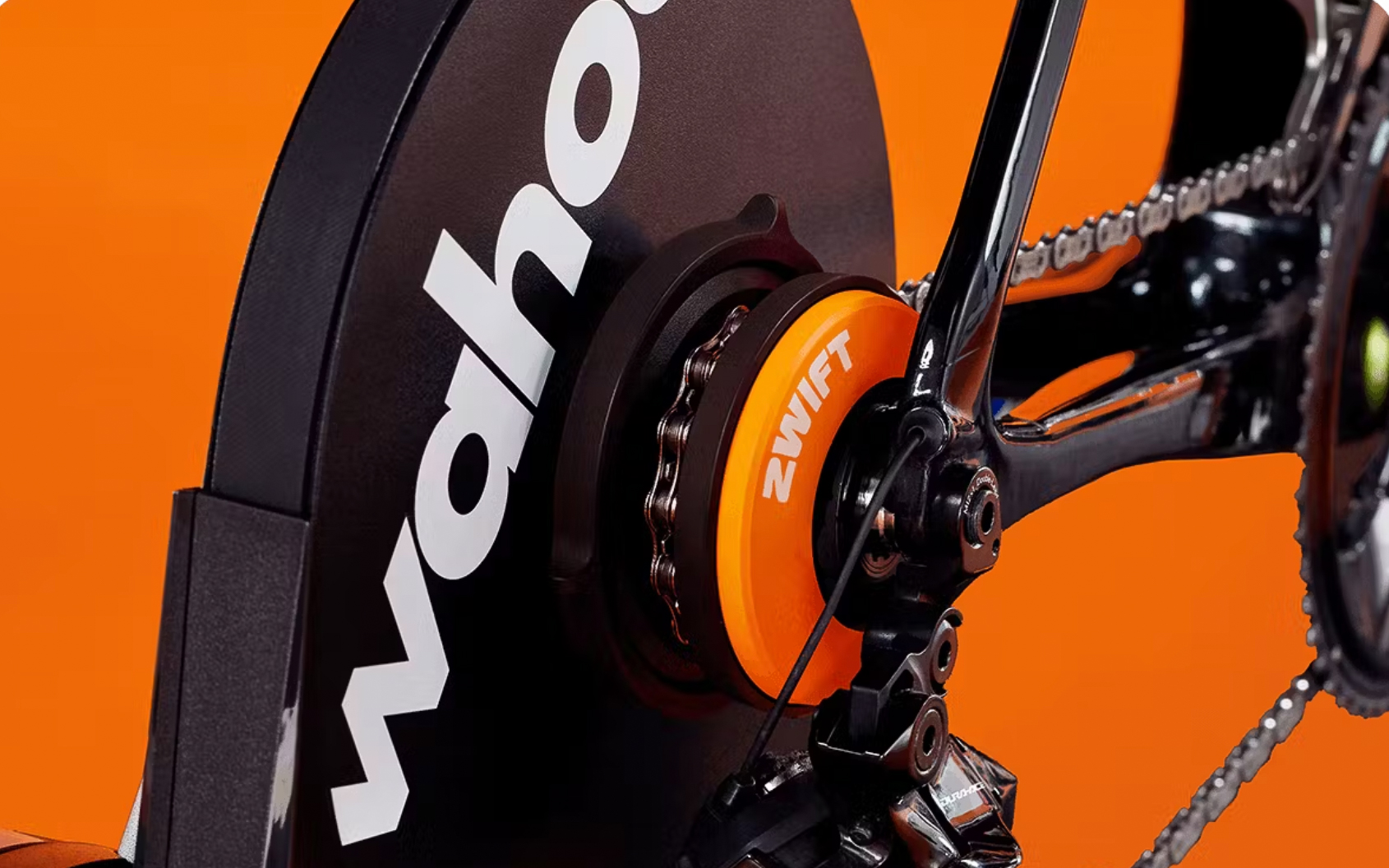
Smart turbo trainers generally have a direct drive design (they come with a cassette that you attach your bike too after taking off the rear wheel), with a built in power meter and the tech to vary the resistance. These turbos will measure your power output, and send this data via ANT+ (you might need an ANT+ dongle for this) or Bluetooth to your computer or device that then feeds into Zwift and your online avatar.
The variable resistance on these turbos will also allow you to feel as if you're actually riding in the online world, so when you are going uphill on-screen the resistance will increase, and when you are going downhill it will decrease.
However you don't have to splash out on an expensive smart turbo trainer to be able to use Zwift. At the most basic level you can use any old turbo trainer combined with an ANT+ or Bluetooth speed sensor (although the system will work better with a power meter).
Data from the speed sensor (or power meter) is then sent to your computer and transferred into the game.
The best turbo training sessions to get the most out of your indoor training page can massively help you get rolling if your stuck for where to start.
Finally, you might need an ANT+ dongle, which is a small USB stick that you can plug into your computer to allow it to communicate with your ANT+ speed sensor, power meter or smart turbo trainer – it's worth noting that most of the latest power meters feature Bluetooth and are compatible with modern laptops, smartphones and tablets.
What are the computer requirements for Zwift?
Zwift can be run on Windows, iOS, iPhone, iPad or AppleTV, and Google Play.
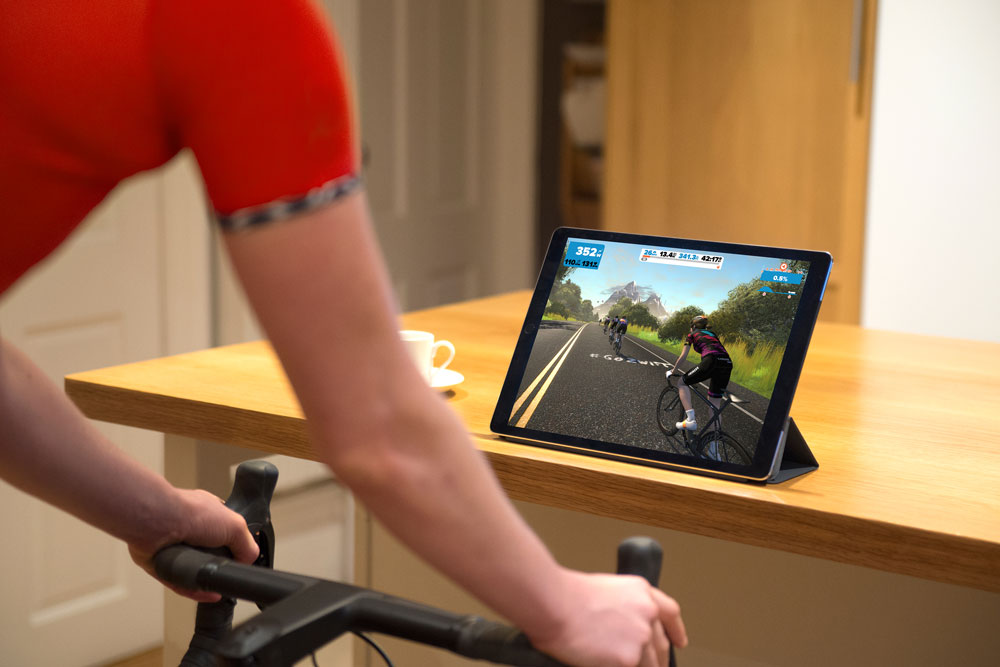
Rider using Zwift on a tablet
The most widely used option is iOS, though an iPad does allow for easy transportation and the AppleTV option is the most cost effective way of using Zwift in full HD on a big screen. Out page on the best Zwift screen setup can help you figure out what will work for you at home.
The current minimum requirements in order to run Zwift are:
- OS: Microsoft Windows 10 64bit or higher, or macOS® 10.14.4
- Processor: Intel Core i3 or AMD Athlon
- Memory: 8GB but ideally 16GB
- Graphics: 1GB dedicated GPU, or embedded Intel HD 4000 or AMD R5
- Hard Drive: Hard disk drive (HDD) with 5GB of free space
- Bluetooth: Version 4.0 or greater
For phone and tablets, as well as casting devices, the requirements are as follows:
- Android: Android 9.0 or higher.
- iOS: iPhone 6S or higher, or iPad 5th Generation or higher.
- RAM: At least 2GB.
- Storage: At least 4GB of free storage space.
- Apple TV: tvOS 14 or higher.
- Chromecast: Compatible for casting from an Android device
How do I set up Zwift?
Once you've got all the equipment, it's time to get riding. The first step is to download the Zwift application onto your device.
You are then prompted to set up an account, and give details such as your gender, height, and weight, which will be used to create your avatar and to give an accurate measurement of your speed in the game.
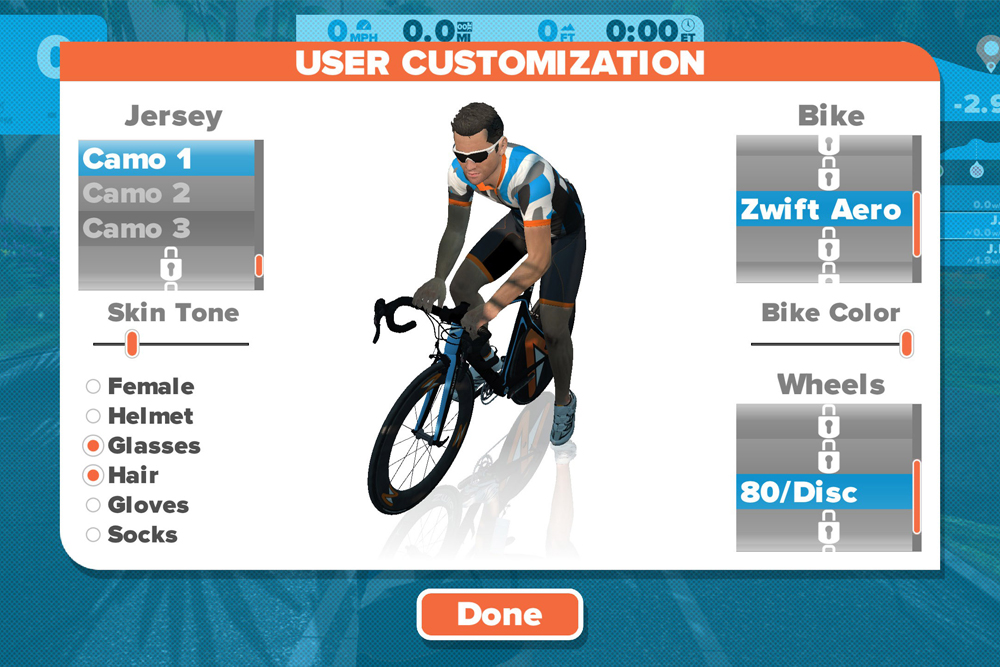
User Customization screen in Zwift
The next step is to set up your avatar to give him or her some nice kit and your dream bike. If you're new to the game then you won't have that many jerseys and bikes to choose from, but as you ride more you will gain achievements and move up through the levels, letting you unlock more outfits, bikes and wheels. There are 100 levels in total all with unlocks, plus event specific unlocks.
Zwift also has the 'Drop Shop' which is an online marketplace where you buy kit and components (once you've reached a high enough level to unlock each item) using an in-game currency that you acquire by stacking up miles on the platform.
Once that's done you're ready to ride.
Where can I ride in Zwift?
There are 12 worlds available on Zwift: the huge base map of Watopia, which has 127 routes, plus smaller maps in London, New York City, Richmond, Yorkshire and Innsbruck. Routes are also available in France, Paris, and Makuri Islands, and in 2023 Zwift hosted the Esports World Championships on a specially created Scotland map with five routes.
There are two event-only maps Bologna and Crit City, and new ones popping up now and then.
While the Richmond and Innsbruck courses are copies of the courses from the 2015 and 2018 Road World Championships respectively, and London uses the route of the Prudential RideLondon Classique, Watopia is a made-up course which has been plonked down somewhere in the Solomon Islands according to Strava. You might struggle to find it on a 'real' map. New York City features roads built mostly within the confines of Central Park. The twist is however, it's 100 years in the future.
The France map was a highly anticipated release on Zwift, as it features a virtual replica of the dreaded Mont Ventoux, while Paris is a recreation of the famous finishing circuit from the final stage of the Tour de France.
Zwift released Makuri Islands in May 2022 with a variety of road types, including tight, flat and winding roads, dirt paths and cobbles, riders can enjoy green fields, and forests, filled with mystical creatures, cherry blossom trees, gushing waterfalls and ancient temples.
Currently 199 of these routes earn you a special achievement badge, and this is one of the ways you can challenge yourself on Zwift without entering a race.
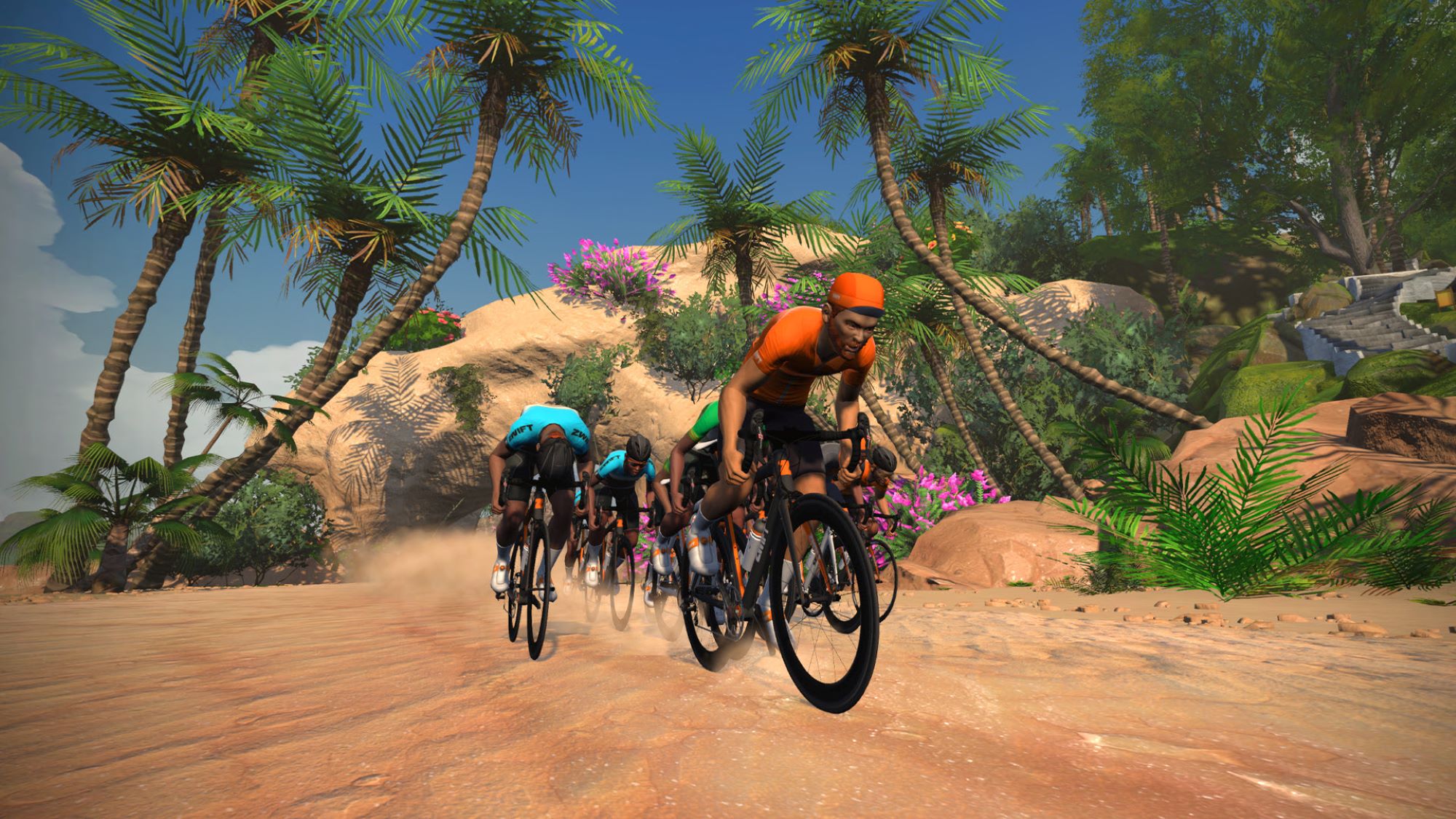
There are a variety of virtual worlds to ride on Zwift
Although there are numerous user-generated Strava segments - yes Strava is also ever-present, although you might find that the seven amazing things you didn't know Strava could do aren't all applicable in virtual worlds.
Each course contains three different official segments, each shown by an arch over the course. The orange arch measures your overall lap time, the green arch measures your time over a short sprint, and the polka dot arch measures your time up a hill such on each course as the Alpe du Zwift on the Road to Sky route.
Your time in each segment is compared to the other riders on the course at that time, and if you're the fastest rider out there then you will be awarded the respective jersey for the rest of your ride (unless somebody beats you of course).
Can I use Zwift for structured training?
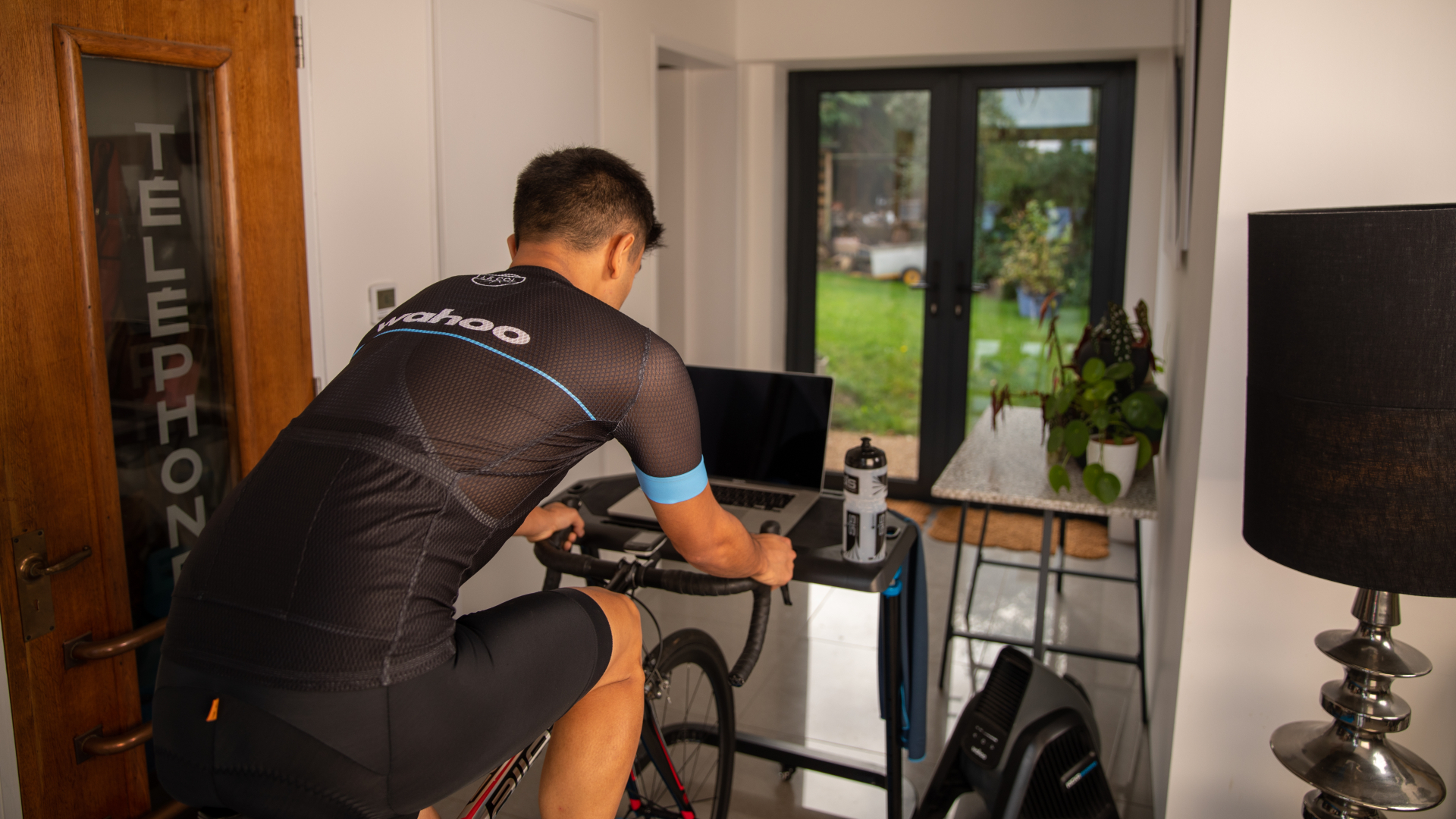
If you're looking to use Zwift for serious training instead of just riding around then you'll probably be interested in Zwift's workout mode, and group workouts.
In group workout mode, riders can train at different intensities but they're kept together in a single peloton.
There are a large number of workouts to choose from. You've got a functional threshold power test, plenty of other individual workouts based on the amount of time you've got available or the sort of workout you're after, as well as full training plans designed by the likes of Marco Pinotti and Chris Carmichael to help you work towards various goals.
The later is ideal for helping to work out how to resume your training after a break off the bike.
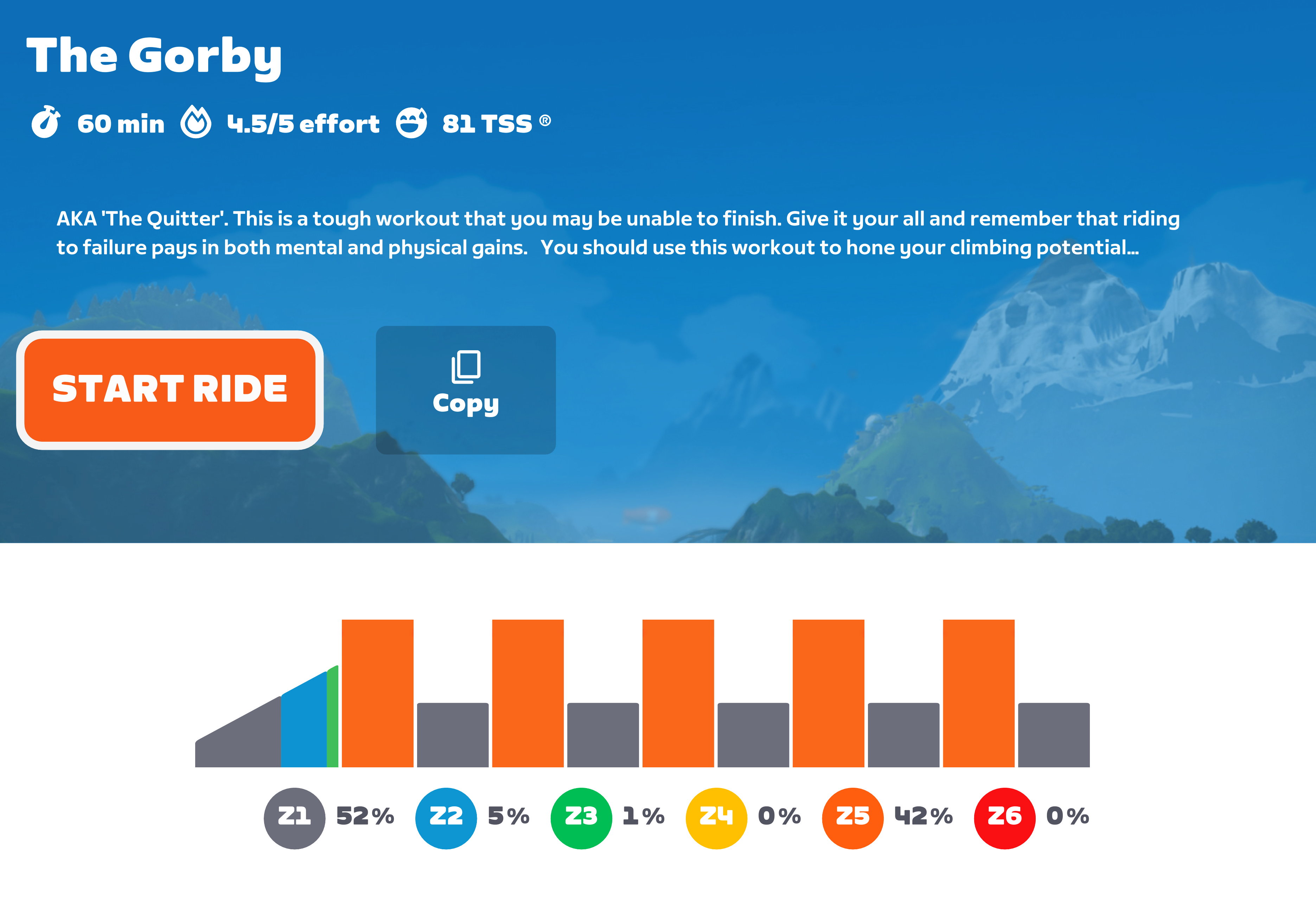
There are 100s of training sessions to follow on Zwift
Once you're riding, the workout is very easy to follow. On the left of the screen you have the overall structure of the workout, at the bottom a graph of your power through the whole of the workout, and at the top an indication of your current power, and the power you should be aiming for in that specific interval.
If you're doing those workouts with a smart trainer then it will adjust the resistance to help you stick at the target power if you're using ERG mode, but if you're just using a standard power meter, then you will have to change the power yourself by adjusting which gear you're in. Simulation mode will also mean your power is affected by the course gradient, so high intensity efforts are best done on the flat or inclines.
Can I race on Zwift?
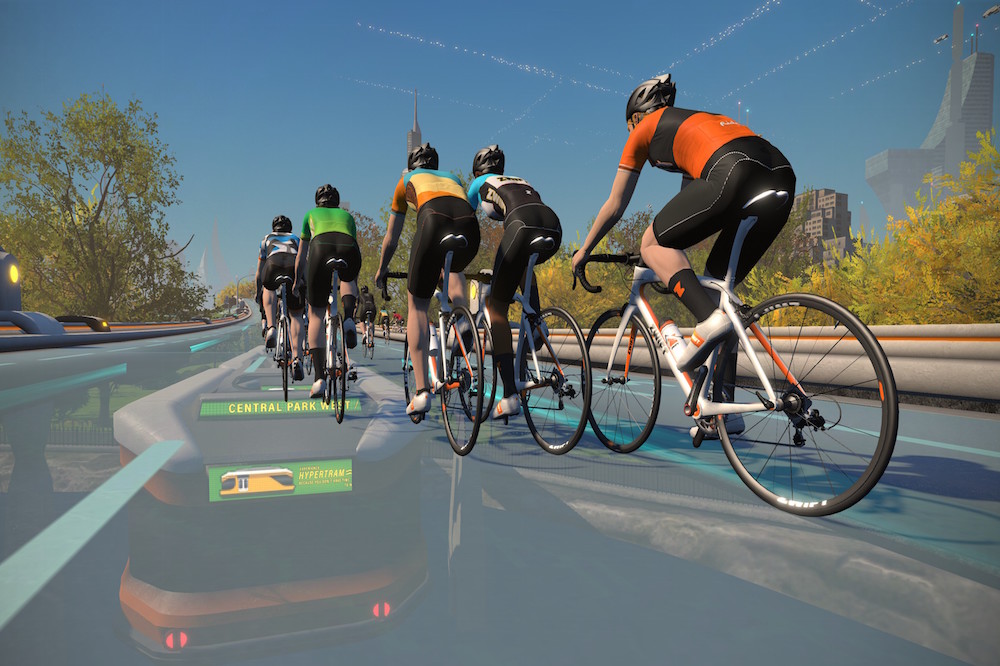
Many Zwift worlds offer a look into futuristic cycling utopias
Yes! Enter virtual racing.
Races on Zwift are published on lists either on the main menu screen before starting the game or on their companion app to join a race, you fire up your Zwift app, join the race - just as you would any group ride on Zwift - and away you go.
To keep races fair, there are Zwift categories. These used to be based upon your FTP (read about training with power here if you don't know what FTP, or functional threshold power, is) and this is still how Pacer Bot rides are categorised:
A: 4.0 w/kg FTP or higher
B: 3.2 w/kg to 4.0 w/kg FTP
C: 2.5 w/kg to 3.2 w/kg FTP
D: Under 2.5 w/kg FTP
Now though, Zwift uses something called the Racing Score. This is set on a scale of 1-1000. This score is initially estimated based on your rides, for your first race at least. After that your score is updated each race based on your finishing position, your competitors' ability, the participant field size, and there's a bonus for a podium finish.
You won't below your 'floor value', which is based on power bests across training rides. So if you never race but have the power values of Tadej Pogačar, you won't be put in the beginner races. Racing scores are as follows:
690-1000
520-690
350-520
180-350
1-180
The Racing Score means you can only join events that accommodate your level. Most events for example have events for different categories, but a level 900 can't enter a race which is 600-800.
Race results are published on ZwiftPower.com, here. In recent years Zwift has reduced the amount of elite level racing on the platform, with the UCI Esport World Championships moving to MyWhoosh from 2024-2026 at the earliest, while the Zwift Games have now been discontinued in favour of community events instead.
It's an appealing list, but if you're still unsure as to what would work best for you then our Zwift vs Peloton: which is best for your at-home workouts? page could help you find a definitive answer.
Zwift Companion app
While not essential, the companion app is a quick an easy way to track your progress, enter events, follow what your friends are doing, join clubs and message other Zwifters. Download the app from the app store and login using the details you inputted when first signing up.
The companion app also makes it easier to write messages when riding (handy for a group ride) and give Ride Ons as it automatically syncs with the main Zwift app when you're riding.
Zwift group rides

There are a few ways you can ride with friends on Zwift - you can agree to meet at a certain point on the map (make sure you choose the same route), you can use the Ride With feature to join someone already riding when you log into Zwift, you can join an organised event, or you can create a MeetUp.
MeetUp is the most effective way of setting up your own group ride - just make sure you're following any riders you want to ride with on Zwift, then find their profile in the Zwift Companion app and tap 'Create MeetUp. You can also visit the Events page and tap the MeetUp icon, then click create.
Choose from the options of a ride or run meetup, and set a date and time. You will then be given a choice between the Watopia map or whichever alternative world is scheduled for that day
Then choose your route, set a total distance or time, and invite anyone else you want to join.
You will also be able to “Customise Your MeetUp”, either by choosing “none” for a normal ride or “Keep Everyone Together” to keep your group whole throughout the ride, regardless of everyone’s power output. Hit send to create the meetup.
Answer a meetup invitation when you receive notification in the game or on the home screen of the Zwift Companion app – click “Going” or “Not Going.”
Log into Zwift before the start and make sure you’re on time (you can't join late), then you'll be notified you a few minutes before it starts to take you to the starting point.
While you’re in the meetup, you’ll still see everyone on the course, but the names of your riding companions will be highlighted in green in the rider list.
Leaderboards will be filtered to show only those in the meetup with you, so you can all contest leader’s jerseys, and when you chat, you’ll only see each other’s messages.
Be aware: you can only invite people to a MeetUp if they're following you, the maximum number of riders you can invite is 50 and you can schedule a ride up to seven days ahead of time.
More on how to set up a Zwift group ride here.
How do I upload Zwift rides to Strava?
All your rides on Zwift are saved onto your computer .fit format, meaning that they can be uploaded onto any training website you care to name.
However, if you just want to upload your rides to Strava then there is an option to connect Zwift with your Strava account on your Zwift dashboard. This will mean that all rides you do on Zwift will be automatically uploaded to Strava.
What is the Zwift Academy?
Ever wondered if your Zwift performances would be enough to keep up with the pros? Well, there's the chance to find out if you have what it takes to win a pro contract through Zwift. This popular feature is the Zwift Academy, an annual series of events that brings together Zwifters for a number of training rides and races.
While recreational riders can enjoy the Zwift Academy and work to improve their fitness, there is also an appeal for the elite riders, as each year there are a number of professional contracts on offer for the best of the best.
Winners of the Zwift Academy talent programme win a pro contract with Canyon-SRAM for the women and Alpecin-Fenix for the men, with former winners including Jay Vine who clinched the first win of his professional career on stage six of the 2022 Vuelta a España, and Ella Harris who has had a very successful start to her pro career.
Riders must complete six workouts, two recovery rides and for the first time this year two benchmarking rides, which will show you how your indoor performances translate to the road.
These benchmarking rides - the Baseline Ride and the Finish Line Ride - will be undertaken at the start and end of the event respectively, as riders take on certain segments to test their sprint, anaerobic and aerobic efforts.
For those new to Zwift Academy, there is also an optional Orientation Workouts - a 25-minute, low intensity workout to take you through the basics.
Stephen Gallagher, co-founder of Dig Deep Coaching and designer of the Zwift Academy workout plan, said: “Zwift Academy is known for its successful talent ID program but it’s so much more for thousands of riders each year.
'“We’ve designed the program to offer even more for those looking to take on the challenge of completing a training plan. The program covers many of the basic principles of training and should be a fun and rewarding experience for all abilities. The segment rides offer a new dynamic - everyone knows what it’s like to beat their personal best on a climb or sprint, so we’ve introduced this element to bring a bit of fun to the ‘testing’.”
Simon Smythe is a hugely experienced cycling tech writer, who has been writing for Cycling Weekly since 2003. Until recently he was our senior tech writer. In his cycling career Simon has mostly focused on time trialling with a national medal, a few open wins and his club's 30-mile record in his palmares. These days he spends most of his time testing road bikes, or on a tandem doing the school run with his younger son.
You must confirm your public display name before commenting
Please logout and then login again, you will then be prompted to enter your display name.
